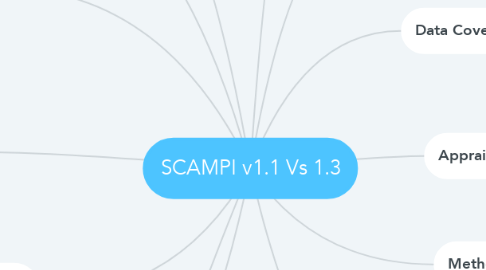SCAMPI v1.1 Vs 1.3
by user internet

1. Terminology Changes
1.1. Basic units: used throughout the document to identify blocks of work or people who form the elements of the organizational unit to be sampled
1.2. Artifacts: the distinction between direct and indirect artifacts has been removed in SCAMPI V1.3
1.3. Practice Implementation Indicator (PII): these terms have been replaced in V1.3 with the labels objective evidence and database of objective evidence
1.4. Focus and non-focus projects: The terms ‘focus project’ and ‘non-focus project’ were removed in V1.3 to better reflect the new sampling approach and to avoid confusion that has occasionally occurred with these terms
1.5. Corroboration: The concept is designed directly into the method rules even though the term ‘corroboration’ itself is de-emphasized.
1.6. Appraisal input: due to the removal of the ARC requirement for ISO/IEC 15504 conformance, this term is no longer used in SCAMPI V1.3
2. Data Collection
2.1. De-emphasizing PIID data structures and distinctions between direct and indirect artifacts
2.2. Sampling approaches to obtain better representation with potentially less data collection impact
2.3. Defining the concept of managed discovery
2.4. Adding emphasis on defining and maintaining a data collection strategy
3. Modes of Usage
3.1. Supplier Selection
3.2. Internal Process Improvement
3.3. Process Monitoring
4. Data Collection, Rating, and Reporting
4.1. Capability Level and/or Maturity Level Ratings
4.2. Goal Satisfaction Ratings
4.3. Practice Implementation Characterizations (organizational unit level)
4.4. Practice Implementation Characterizations (practice instantiation level)
5. Instruments and Tools
5.1. Instruments also often provide an opportunity for the organizational unit to provide a selfcharacterization of their implemented processes
5.2. An appraisal team member should facilitate the entry of data into instruments where feasible to ensure that appropriate data are obtained
6. Conducting Cost-Effective Appraisals
6.1. that can help achieve cost-effective SCAMPI A appraisals and maximize business returns
7. Strategies for Planning Cost-Effective SCAMPI Appraisals
7.1. Observation: Inefficient collection of data from the appraised organization has been a driver of high appraisal costs.
7.2. Method: Revisions made to the method clarified and contrasted data collection approaches
7.3. Recommendations: Negotiate expectations for the delivery of data to the appraisal team
8. Broadened Applicability of SCAMPI Method
8.1. synchronize with other components of the CMMI product suite
8.2. support single-model CMMI-DEV appraisals
8.3. uses more generic terminology to better accommodate the architectures used in these other reference models
8.4. guidance has been added (refer to Appendix G) on how to conduct a SCAMPI appraisal using more than one reference model (i.e., multi-model appraisals)
9. Appraisal Scoping and Sampling
9.1. Planning and selection of the organizational scope of the appraisal is now based on quantitative sampling rules to ensure adequate representation of basic units across the organizational unit
9.2. offering opportunities to optimize data collection and appraisal costs
9.3. based on analysis of sampling factors (formerly called critical factors in V1.2) and subgroups that characterize differing definitions or implementations of the processes in use within the organizational unit
9.4. Details on appraisal scoping and sampling
9.5. Determine Appraisal Scope and Appendix F, Scoping and Sampling in SCAMPI A Appraisals
10. Data Coverage Rules
10.1. new method rules are defined for the amount of objective evidence (artifacts and/or affirmations)
10.2. affirmations were required across process instantiations
11. Appraisal Team Qualifications
11.1. Objectivity is assured by mitigating potential conflicts of interest
12. Method Concepts
12.1. SCAMPI A is a Class A benchmarking method.
12.2. The aggregate of objective evidence provided is used as the basis for determining practice implementation.
12.3. Practice implementation at the organizational unit level is a function of the degree of practice implementation at the instantiation level.
13. Generating Findings
13.1. aggregated to statements of preliminary findings
13.2. Preliminary findings are provided to the organizational unit for validation


